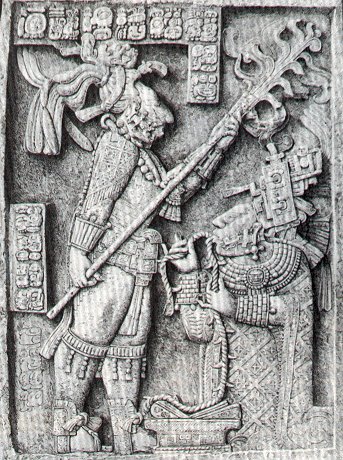
Désiré Charnay
Encyclopedia
Claude-Joseph Désiré Charnay (2 May 1828 – 24 October 1915) was a French
France
The French Republic , The French Republic , The French Republic , (commonly known as France , is a unitary semi-presidential republic in Western Europe with several overseas territories and islands located on other continents and in the Indian, Pacific, and Atlantic oceans. Metropolitan France...
traveller and archaeologist notable both for his explorations of Mexico
Mexico
The United Mexican States , commonly known as Mexico , is a federal constitutional republic in North America. It is bordered on the north by the United States; on the south and west by the Pacific Ocean; on the southeast by Guatemala, Belize, and the Caribbean Sea; and on the east by the Gulf of...
and Central America
Central America
Central America is the central geographic region of the Americas. It is the southernmost, isthmian portion of the North American continent, which connects with South America on the southeast. When considered part of the unified continental model, it is considered a subcontinent...
, and for the pioneering use of photography
Photography
Photography is the art, science and practice of creating durable images by recording light or other electromagnetic radiation, either electronically by means of an image sensor or chemically by means of a light-sensitive material such as photographic film...
to document his discoveries.

Fleurie
Fleurie is a commune in the Rhône department in eastern France.Medieval charters record Fleurie as Floriacum..Fleurie AOC is a division of the Beaujolais wine region. In the 1970s the British Conservative politician and tax fugitive Ernest Marples owned a Fleurie château and vineyard, to which he...
, and studied at the Lycée Charlemagne
Lycée Charlemagne
The Lycée Charlemagne is located in the Marais quarter of the 4th arrondissement of Paris, the capital city of France.Constructed many centuries before it became a lycée, the building originally served as the home of the Order of the Jesuits...
. In 1850, he became a teacher in New Orleans, Louisiana
New Orleans, Louisiana
New Orleans is a major United States port and the largest city and metropolitan area in the state of Louisiana. The New Orleans metropolitan area has a population of 1,235,650 as of 2009, the 46th largest in the USA. The New Orleans – Metairie – Bogalusa combined statistical area has a population...
, and there became acquainted with John Lloyd Stephens
John Lloyd Stephens
John Lloyd Stephens was an American explorer, writer, and diplomat. Stephens was a pivotal figure in the rediscovery of Maya civilization throughout Middle America and in the planning of the Panama railroad....
's books of travel in Yucatan
Yucatán
Yucatán officially Estado Libre y Soberano de Yucatán is one of the 31 states which, with the Federal District, comprise the 32 Federal Entities of Mexico. It is divided in 106 municipalities and its capital city is Mérida....
. He travelled in Mexico, under a commission from the French ministry of education, in 1857-1861; in Madagascar
Madagascar
The Republic of Madagascar is an island country located in the Indian Ocean off the southeastern coast of Africa...
in 1863; in South America
South America
South America is a continent situated in the Western Hemisphere, mostly in the Southern Hemisphere, with a relatively small portion in the Northern Hemisphere. The continent is also considered a subcontinent of the Americas. It is bordered on the west by the Pacific Ocean and on the north and east...
, particularly Chile
Chile
Chile ,officially the Republic of Chile , is a country in South America occupying a long, narrow coastal strip between the Andes mountains to the east and the Pacific Ocean to the west. It borders Peru to the north, Bolivia to the northeast, Argentina to the east, and the Drake Passage in the far...
and Argentina
Argentina
Argentina , officially the Argentine Republic , is the second largest country in South America by land area, after Brazil. It is constituted as a federation of 23 provinces and an autonomous city, Buenos Aires...
, in 1875; and in Java and Australia
Australia
Australia , officially the Commonwealth of Australia, is a country in the Southern Hemisphere comprising the mainland of the Australian continent, the island of Tasmania, and numerous smaller islands in the Indian and Pacific Oceans. It is the world's sixth-largest country by total area...
in 1878. In 1880-1883, he again visited the ruined cities of Mexico. Pierre Lorillard IV
Pierre Lorillard IV
Pierre Lorillard IV was an American tobacco manufacturer and thoroughbred race horse owner.-Biography:...
of New York City
New York City
New York is the most populous city in the United States and the center of the New York Metropolitan Area, one of the most populous metropolitan areas in the world. New York exerts a significant impact upon global commerce, finance, media, art, fashion, research, technology, education, and...
contributed to defray the expense of this expedition, and Charnay named a great ruined city near the Guatemala
Guatemala
Guatemala is a country in Central America bordered by Mexico to the north and west, the Pacific Ocean to the southwest, Belize to the northeast, the Caribbean to the east, and Honduras and El Salvador to the southeast...
n boundary line "Ville Lorillard" in his honor; the name did not stick and the site is more commonly known as Yaxchilan
Yaxchilan
Yaxchilan is an ancient Maya city located on the bank of the Usumacinta River in what is now the state of Chiapas, Mexico. In the Late Classic Period Yaxchilan was one of the most powerful Maya states along the course of the Usumacinta, with Piedras Negras as its major rival...
. Charnay went to Yucatan in 1886.
The more important of his publications are (1863), being his personal report on the expedition of 1857-1861, of which the official report is to be found in Viollet-le-Duc's (1863), vol. 19 of ; (1885; English translation, The Ancient Cities of the New World, 1887, by Mmes. Gonino and Conant); a romance, (1888); (1890); and (1903).
He translated Hernán Cortés
Hernán Cortés
Hernán Cortés de Monroy y Pizarro, 1st Marquis of the Valley of Oaxaca was a Spanish Conquistador who led an expedition that caused the fall of the Aztec Empire and brought large portions of mainland Mexico under the rule of the King of Castile in the early 16th century...
's letters into French, under the title Lettres de Fernand Cortès à Charles Quint sur la découverte et la conquête du Mexique (1896). He elaborated a theory of Toltec
Toltec
The Toltec culture is an archaeological Mesoamerican culture that dominated a state centered in Tula, Hidalgo in the early post-classic period of Mesoamerican chronology...
migrations and considered the prehistoric Mexican to be of Asia
Asia
Asia is the world's largest and most populous continent, located primarily in the eastern and northern hemispheres. It covers 8.7% of the Earth's total surface area and with approximately 3.879 billion people, it hosts 60% of the world's current human population...
tic origin, because of supposed observed similarities to Japanese architecture, Chinese decoration, Malaysian language and Cambodian dress, and so forth.
External links
- Works available at Gallica, Bibliothèque nationale de FranceBibliothèque nationale de FranceThe is the National Library of France, located in Paris. It is intended to be the repository of all that is published in France. The current president of the library is Bruno Racine.-History:...
- Photographs and prints of Uxmal and Kabah by Charnay (Reed College, Portland, Oregon)

